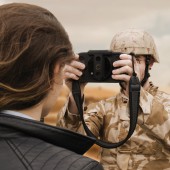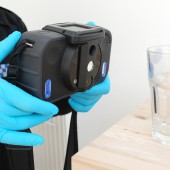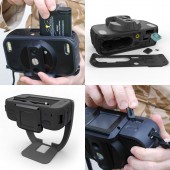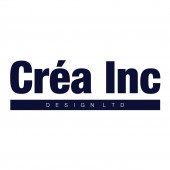Unity Biometric Capture TabletPC by Travis Baldwin, Keith Grethen, Bill Willis |
Home > Winners > #47286 |
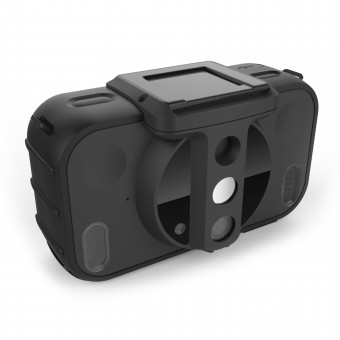 |
|
||||
| DESIGN DETAILS | |||||
| DESIGN NAME: Unity PRIMARY FUNCTION: Biometric Capture TabletPC INSPIRATION: Unity was inspired by needs for a mobile, off the grid, identity device capturing multiple biometric signatures & processing within the same product. It’s the next step in multimodal biometrics as a high quality, economical, & integrated solution. Aesthetics build upon our established design language, combining rubber grips and hard plastic coversets. Exterior design simplifies the dozen complex sensors into simple shapes like cylinders and blocks. Design cues strive for ‘serious’ ‘rugged’ look. UNIQUE PROPERTIES / PROJECT DESCRIPTION: Unity combines multiple biometric sensors & a 64bit PC in a rugged design. It captures dual irises, faces, & fingerprints from surfaces or by scanner. They can be matched against millions of profiles stored on the device instantly. It’s optimized for size, packing more power & sensors in the smallest package available. Users include customs, border, military, emergency, & ID programs. It’s perfect for identifying people in remote, disconnected locations, such as medical treatment in rural India. OPERATION / FLOW / INTERACTION: Unity is a stand-alone, biometric capture pc to register & identify people off the network. It is for: registering people, recognizing people, & evidence capture at crime scenes. In registration/ID, the user would bring the camera to the subject’s face level, capture face & iris images, then position fingers to scan prints. Profiles are logged or matched against saved profiles. Alarms trigger for wanted people. For police, Unity records biometrics, body art, crime scene, & fingerprints from surfaces. It is also a normal PC for email, video chat, navigation, and programs. PROJECT DURATION AND LOCATION: The project started in December 2013, in San Carlos California (USA), Washington D.C. (USA), and Bristol, UK. The project was first produced in September 2014 and further design revisions were carried out until July 2015. |
PRODUCTION / REALIZATION TECHNOLOGY: Unity was a ‘clean-sheet’ design creating a new product from a loose brief. We started with an electronic spec, capture needs, general markets, & size. Unity was planned, parts were used for layout concepts, then reviewed for user & design benefits. Foam models allowed ergonomics refinement. For thermal issues, FEA modeling was done. Exterior design built upon layout favorites, exterior form was sketched, then detailed into robust parts. Ideas evolved & features were added, improving function & ease of use Hardware was verified in working prototypes. Accessories were later designed. SPECIFICATIONS / TECHNICAL PROPERTIES: Unity combines a PC, storage, antenna, battery, & interface w/ biometric sensors, lens, & illuminators in a small rugged package. It has a dual 1.8 Ghz 64 bit chip, 256 gb ssd, 4 gb ram, GPS, wifi, & 4G. There are hot swap & standby batteries, 5” multi-touch daylight screen, & an ip54 sealed case. An accessory sunshade, passport reader, & fingerprint stand can be attached. Fingerprint sensor, Iris & Face Camera, distance sensor, & multispectral LED are used for capture. It uses windows 10 & Raven DB software. It is TPE rubber, PC-ABS plastic, metal, and glass filters. 18.3 x 10.7 x 7.4 cm, 1.13 Kg. TAGS: Biometric, Camera, Iris, Face, Recognition, Rugged, TabletPC, Fingerprint, Multi-Modal RESEARCH ABSTRACT: Research was done for many areas of Unity. For user ergonomics, concept models were evaluated for comfort near sensor locations & component ‘lumps’. Layouts optimized grip, sensor exposure, & usage. Accessories would attach to Unity but had to fold flat, requiring material research for folding shapes. To cool the processor, workshops explored aesthetics & functionality concepts, then were evaluated in FEA models. Ultimately, physical cooling parts were made & tested. Sealing research studied existing products, evaluated techniques, and applied the learning to Unity. CHALLENGE: The main challenge was packing so much in the small product enclosure w/out sacrificing quality, performance, or aesthetics. We had to fit the device in a fixed size envelope, with ip54 sealing & effective cooling. We started conceptualizing different layouts, evaluating often against the brief. Best designs fit both usage & design goals. Engineering details such as structure, doors, material layers, cooling, sealing, etc. were added, filling the internal space. The basic form is literally packed with electronics, sensors, lenses, batteries, air passages, & internal structure. ADDED DATE: 2016-02-28 20:46:28 TEAM MEMBERS (7) : CEO (Corvus): Jeff Kormanec, President (Corvus): Steven Muir, Program Manager (Corvus): Bill Willis, Technical Lead (Vista Imaging): Chris Dopp, Electrical Engineering (Vista Imaging): Keith Grethen, Software Engineering (Vista Imaging): Ted Stein and Industrial & Mechanical Design (Crea Inc Design LTD): Travis Baldwin IMAGE CREDITS: Photographer Travis Baldwin, Unity Photos, 2015. Illustrator Travis Baldwin, Unity Renderings, 2015-2016. |
||||
| Visit the following page to learn more: http://www.corvusid.com/ | |||||
| AWARD DETAILS | |
 |
Unity Biometric Capture Tabletpc by Travis Baldwin, Keith Grethen, Bill Willis is Winner in Security, Safety and Surveillance Products Design Category, 2015 - 2016.· Read the interview with designer Travis Baldwin, Keith Grethen, Bill Willis for design Unity here.· Press Members: Login or Register to request an exclusive interview with Travis Baldwin, Keith Grethen, Bill Willis. · Click here to register inorder to view the profile and other works by Travis Baldwin, Keith Grethen, Bill Willis. |
| SOCIAL |
| + Add to Likes / Favorites | Send to My Email | Comment | Testimonials | View Press-Release | Press Kit |
Did you like Travis Baldwin, Keith Grethen, Bill Willis' Security Products Design?
You will most likely enjoy other award winning security products design as well.
Click here to view more Award Winning Security Products Design.


